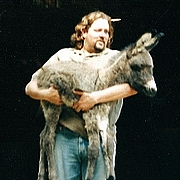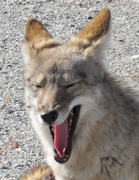Can anyone confirm whether this is in fact a Western Wallflower?
My searches of the Internets suggests that it is Erysimum capitatum ssp. lompocense but the pictures I'm finding are not an exact match. I'm new to the wildflower game and don't have a good sense of how much variation there is even within a subspecies.
Thanks!
Western Wallflower?
-
PackerGreg

- Posts: 623
- Joined: Sat Sep 12, 2009 9:31 pm
That is the Genus-species of Wallflower in the San Gabriels, but that subspecies (ssp.) lompocense means that it is named for the city of Lompoc, north of Santa Barbara, and in fact the link calls it the San Louis Obispo Wallflower. There may be quite a few subspecies of Erysimum capitatum endemic to isolated regions throughout its range.
From Cliff & Gabi Mclean's Plants of Eaton Canyon CD...
Western Wallflower
(Erysimum capitatum)
Mustard Family
(Brassicaceae)
Western Wallflower is a biennial or short-lived perennial herb, in the Mustard family, that stands between 1 and 3 feet tall. It often grows—true to its name—on rocky outcrops. The showy, yellow-orange flowers at the top of the stems draw your attention like a beacon. This plant has long, narrow leaves on the lower stem.
Leaves: Western Wallflower, like most species in the Mustard family, has both a rosette of basal leaves and leaves that grow on the stems. The dark green leaves are long and narrow, and sometimes have a sparsely toothed edge.
Flowers: The bright yellow-orange flowers have 4 petals and, like all members of the Mustard family, 6 stamens (4 long ones and 2 short ones). The flowers are in clusters at the ends of the stems. The stems continue growing, with new flowers forming as they grow, while the spent flowers, below, produce fruits.
Fruit: The fruit is a long, narrow silique, up to 4 inches long, with many seeds. It extends from a 1/4-inch-long pedicel. There are many fruits on a stem and they develop while the plant continues flowering. They generally point upward.
Habitat: Wallflower grows in many different areas, at nearly all elevations of the San Gabriel Mountains.
Related Species: This is the only species of Erysimum in Eaton Canyon and the San Gabriel foothills. However, there many species in other genera of the Mustard family in the canyons and foothills of the San Gabriels.
Range: This native plant grows in most of California, except the Central Valley, and extends into the east-central United States.
Meaning of the Name: Erysimum is from the Greek meaning "to help or aid", in reference to the medicinal uses of this plant; capitatum indicates that the flowers grow in a dense head, and is from the Latin caput, "head".
Apparently, the source of the common name, Wallflower, is this plant’s habit of growing on and next to canyon walls.

From Cliff & Gabi Mclean's Plants of Eaton Canyon CD...
Western Wallflower
(Erysimum capitatum)
Mustard Family
(Brassicaceae)
Western Wallflower is a biennial or short-lived perennial herb, in the Mustard family, that stands between 1 and 3 feet tall. It often grows—true to its name—on rocky outcrops. The showy, yellow-orange flowers at the top of the stems draw your attention like a beacon. This plant has long, narrow leaves on the lower stem.
Leaves: Western Wallflower, like most species in the Mustard family, has both a rosette of basal leaves and leaves that grow on the stems. The dark green leaves are long and narrow, and sometimes have a sparsely toothed edge.
Flowers: The bright yellow-orange flowers have 4 petals and, like all members of the Mustard family, 6 stamens (4 long ones and 2 short ones). The flowers are in clusters at the ends of the stems. The stems continue growing, with new flowers forming as they grow, while the spent flowers, below, produce fruits.
Fruit: The fruit is a long, narrow silique, up to 4 inches long, with many seeds. It extends from a 1/4-inch-long pedicel. There are many fruits on a stem and they develop while the plant continues flowering. They generally point upward.
Habitat: Wallflower grows in many different areas, at nearly all elevations of the San Gabriel Mountains.
Related Species: This is the only species of Erysimum in Eaton Canyon and the San Gabriel foothills. However, there many species in other genera of the Mustard family in the canyons and foothills of the San Gabriels.
Range: This native plant grows in most of California, except the Central Valley, and extends into the east-central United States.
Meaning of the Name: Erysimum is from the Greek meaning "to help or aid", in reference to the medicinal uses of this plant; capitatum indicates that the flowers grow in a dense head, and is from the Latin caput, "head".
Apparently, the source of the common name, Wallflower, is this plant’s habit of growing on and next to canyon walls.

-
PackerGreg

- Posts: 623
- Joined: Sat Sep 12, 2009 9:31 pm
Plants of the San Gabriel Mountains CD:
http://www.natureathand.com/SGF_Plants/SGFIntro.htm
Common Plants of Eaton Canyon CD:
http://www.natureathand.com/EC_Plants/ECFieldGuide.htm
All written in html so they work on any system
http://www.natureathand.com/SGF_Plants/SGFIntro.htm
Common Plants of Eaton Canyon CD:
http://www.natureathand.com/EC_Plants/ECFieldGuide.htm
All written in html so they work on any system
-
turtle

- Posts: 152
- Joined: Wed Jan 27, 2010 11:35 am
Wow... thanks for the very thorough and informative response!
-
norma r

- Posts: 707
- Joined: Thu Nov 06, 2008 4:22 pm
PackerGreg, thanks for the link from me too! i did not know about that one and i have a whole Favorites Folder tab on my pc dedicated to flowers since i love trying to ID them.
-
Kit Fox

- Posts: 152
- Joined: Tue Dec 25, 2007 11:33 am
turtle wrote:Wow... thanks for the very thorough and informative response!
My link isn't quite as exciting, but they do have a great wildflower ID discussion.
http://www.flickr.com/groups/califlora/ ... 890077766/
-
norma r

- Posts: 707
- Joined: Thu Nov 06, 2008 4:22 pm
thanx Kit Fox! i joined. look forward to their help with ID'ing.
